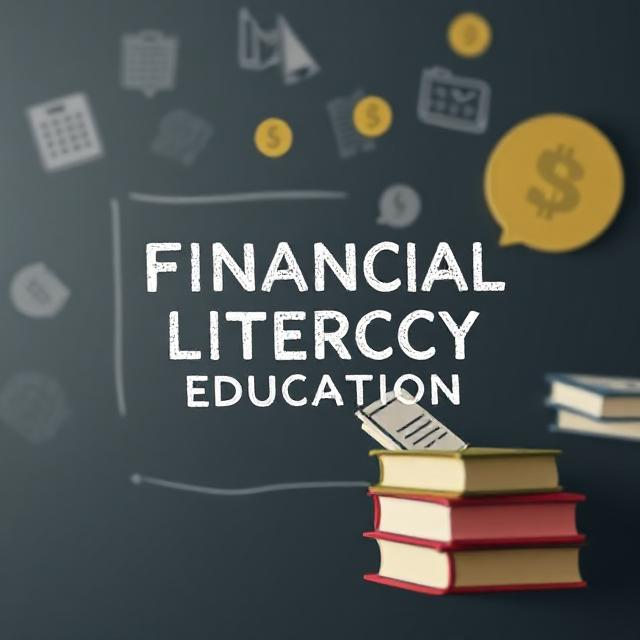What is Financial Literacy Education and Why Does It Matter?
Let’s start with the basics. Financial literacy education is all about understanding how money works—how to earn it, save it, invest it, and spend it wisely. Think of it as a survival toolkit for navigating the modern world. Without it, you’re essentially wandering through a financial jungle without a map.
The truth is, most people learn about money the hard way—through trial and error. But imagine if you could skip the costly mistakes and jump straight to financial success. That’s where financial literacy education comes in. It equips you with the knowledge to make smarter decisions, whether you’re budgeting for groceries or planning for retirement.
The Shocking Truth About Financial Literacy Education in Schools
Here’s a harsh reality: most schools don’t teach financial literacy education . According to a government report , only 21 states require high school students to take a personal finance course. This gap leaves millions of young adults unprepared to manage their finances.
Without proper guidance, many fall into traps like credit card debt, student loans, and poor investment choices. It’s no wonder that financial stress is one of the leading causes of anxiety worldwide. If we want to break this cycle, we need to prioritize financial literacy education from an early age.
Top 5 Benefits of Financial Literacy Education
So, what makes financial literacy education so powerful? Here are five life-changing benefits:
- Better Money Management: You’ll learn how to create budgets, track expenses, and avoid overspending.
- Debt Avoidance and Reduction: Understanding interest rates and repayment plans can help you stay debt-free.
- Increased Savings: With the right strategies, you can build an emergency fund and plan for big purchases.
- Confidence in Decision-Making: No more second-guessing yourself when it comes to financial choices.
- Path to Financial Independence: Mastering financial literacy education puts you in control of your future.
For more tips, check out our related article: “How to Build a Budget That Works for You.”
How to Start Your Financial Literacy Education Journey
Ready to take charge of your finances? The good news is, you don’t need a fancy degree to get started. There are countless resources available online. Websites like Investopedia and Wikipedia’s Personal Finance page offer free guides to help you understand the basics.
If you prefer interactive tools, apps like Mint or YNAB (You Need A Budget) can simplify money management. And don’t forget to explore internal resources at financefling.com , where we dive deeper into topics like saving and investing.
The Role of Financial Literacy Education in Achieving Financial Independence
Want to retire early or travel the world? Financial literacy education is your ticket to achieving these dreams. By learning how to invest wisely, you can grow your wealth over time. Stocks, bonds, real estate—these aren’t just buzzwords; they’re tools that can help you build a secure future.
But here’s the catch: you need to start early. Compound interest is like planting a tree—the earlier you plant, the bigger it grows. For more insights, read our article: “Smart Investing Strategies for Beginners.”
Budgeting 101: A Key Component of Financial Literacy Education
At the heart of financial literacy education lies budgeting. It’s not the most exciting topic, but it’s absolutely essential. A budget helps you allocate your income toward needs, wants, and savings.
Start by listing your monthly expenses, then categorize them. Tools like spreadsheets or budgeting apps can make this process easier. Remember, a budget isn’t about restriction—it’s about freedom. When you know where your money is going, you can make intentional choices that align with your goals.
Future-Proof Your Finances with Financial Literacy Education
In today’s fast-paced world, change is constant. New technologies, economic shifts, and global events can impact your finances overnight. That’s why ongoing financial literacy education is crucial. Stay informed by following trusted sources like CNBC and subscribing to newsletters from reputable financial institutions.
And don’t forget to revisit your financial plan regularly. Life changes, and so should your strategies. For example, if you’re planning for a family, you might want to explore articles like “How to Save for College Without Breaking the Bank.”
Common Myths About Financial Literacy Education Debunked
There are plenty of misconceptions about financial literacy education . Let’s clear up a few:
- “It’s Only for Rich People”: Wrong! Anyone can benefit from learning how to manage money effectively.
- “You Need a Degree to Understand It”: Not true. Many free resources explain complex concepts in simple terms.
- “It’s Too Late to Start”: It’s never too late. Every step you take toward financial literacy brings you closer to stability.
Government Initiatives Promoting Financial Literacy Education
Governments around the world are recognizing the importance of financial literacy education . In the U.S., the Consumer Financial Protection Bureau (CFPB) offers free resources to help individuals improve their financial skills. Similar programs exist in Canada, Australia, and the UK.
Take advantage of these initiatives—they’re designed to empower you. Whether it’s a workshop, webinar, or downloadable guide, there’s something for everyone.
Teaching Kids Financial Literacy Education Early
Parents play a vital role in shaping their children’s financial habits. Start by introducing basic concepts like saving and spending. Give them a piggy bank or open a junior savings account.
Games like Monopoly or apps like Greenlight can make learning fun. Encourage them to set savings goals, whether it’s for a toy or a special outing. Teaching kids financial literacy education sets them up for lifelong success.
Resources for Lifelong Financial Literacy Education
Learning doesn’t stop after school—or after reading this article! Keep expanding your knowledge with these resources:
- Books: Rich Dad Poor Dad by Robert Kiyosaki, The Total Money Makeover by Dave Ramsey
- Podcasts: “The Dave Ramsey Show,” “ChooseFI”
- YouTube Channels: Graham Stephan, The Financial Diet
For more recommendations, visit financefling.com .
Conclusion
Financial literacy education isn’t just a skill—it’s a superpower. It empowers you to take control of your money, avoid unnecessary stress, and achieve your dreams. Whether you’re starting from scratch or looking to refine your knowledge, every step counts. So, what are you waiting for? Begin your journey today and watch your financial confidence soar.
FAQs
- What is the best way to learn financial literacy education?
Start with free online resources, books, and apps tailored to beginners. - Can financial literacy education help me get out of debt?
Absolutely! It teaches you strategies to manage and eliminate debt effectively. - Is financial literacy education important for kids?
Yes, teaching kids early instills healthy money habits that last a lifetime. - Where can I find government resources on financial literacy education?
Visit websites like CFPB.gov for free guides and tools. - How often should I update my financial literacy education?
Regularly! Financial markets and personal circumstances change, so staying informed is key.
Three-Word Keywords (Comma-Separated Format):
Financial literacy skills, money management tips, personal finance education





